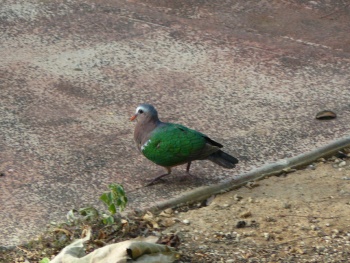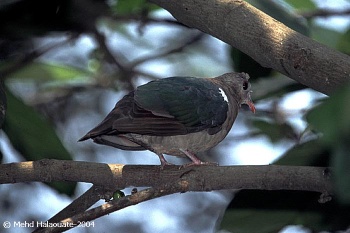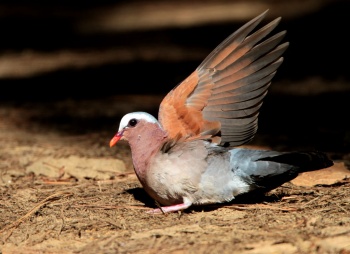- Chalcophaps indica
Identification
23–27 cm (9-10¾ in) A small and short-tailed dove.
- Emerald-green on wings and mantle
- Primaries and outer secondaries slaty black with chestnut on inner webs
- Dark brownish purple neck and breast
- Black tail
Male
- White forehead and supercilium
- White shoulder
Flight
- Small and stocky dove
- Diagnostic pale lower back-bars
Distribution
This species has a wide distribution in southeast Asia and Australasia. From the Indian Subcontinent to south China, Myanmar, Thailand, Vietnam, Laos, Cambodia, Philippines, Malaysia, Indonesia, Christmas Island, and islands off Papua New Guinea.
Introduced in Hong Kong.
Not migratory, but local wandering occurs. Sometimes birds are found well out of their natural range, e.g. Maldive Islands.
Taxonomy
Formerly considered conspecific with Pacific Emerald Dove.
Subspecies
Six subspecies are recognized:
- C.i.indica from India to the Philippines
- C.i.robinsoni of Sri Lanka
- C.i.maxima on Andaman Islands
- C.i.augusta on Nicobar Islands
- C.i.natalis on Christmas Island
- C.i.minima Numfoor Island, Biak Island, Mios Num Island, Irian Jaya
Habitat
Different types of forest: rain forest, mangroves, gallery forest, clearings, orchards and plantations near forest, and possibly sometimes in drier habitat.
Behaviour
Often quite tame, but hard to discover in the forest. May feed inconspicuously on ground. Usually found when dashing in direct flight through the forest. Flies often into windows and may be attracted by lights at night.
Breeding
Breeds all year round. Nest is a platform of twigs in a tree or a bush. Lays 2 eggs.
Diet
Feeds mostly on fallen fruit and seeds, also on invertebrates (termites, snails, insects). May feed in farmyards together with domestic fowl. Usually feeds singly on the ground, sometimes in pairs.
References
- Clements, J. F., T. S. Schulenberg, M. J. Iliff, S. M. Billerman, T. A. Fredericks, J. A. Gerbracht, D. Lepage, B. L. Sullivan, and C. L. Wood. 2021. The eBird/Clements checklist of Birds of the World: v2021. Downloaded from https://www.birds.cornell.edu/clementschecklist/download/
- Grimmett, R, C Inskipp, and T Inskipp. 2012. Birds of India, Pakistan, Nepal, Bangladesh, Bhutan, Sri Lanka, and The Maldives, second edition. Princeton, NJ, USA: Princeton University Press. ISBN 978-0691153490
Recommended Citation
- BirdForum Opus contributors. (2024) Asian Emerald Dove. In: BirdForum, the forum for wild birds and birding. Retrieved 26 July 2024 from https://www.birdforum.net/opus/Asian_Emerald_Dove
External Links
GSearch checked for 2020 platform.1







